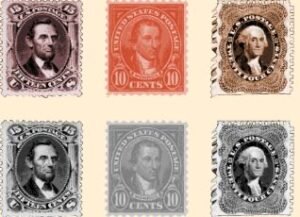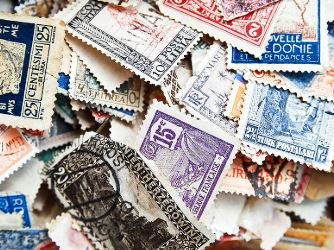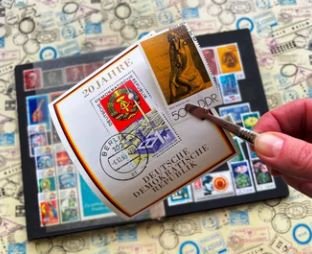Stamp collecting, also known as philately, is one of the most rewarding hobbies, with antique stamps often fetching high prices due to their rarity, historical significance, and condition. However, identifying valuable antique stamps can be challenging, especially with the rise of counterfeit stamps that try to deceive collectors. The Antique Stamps Identification Guide: Discover Hidden Valuables and Watch Out for Scams will walk you through how to identify rare and valuable stamps while also warning you about common scams in the market.
Whether you’re just starting your collection or looking to appraise an old album, knowing how to identify authentic antique stamps is essential to ensure you don’t fall for fraudulent claims or overpriced fakes. In this guide, we’ll break down the essential steps for identifying genuine antique stamps and provide tips on how to avoid common scams.

Why Knowing the Antique Stamps Identification Guide Is Crucial
The antique stamp market is full of hidden treasures that can be worth thousands, if not millions, of dollars. However, the market is also rife with counterfeit stamps that are made to appear as though they’re rare and valuable. To avoid being misled, you need a solid understanding of how to identify antique stamps and determine their true worth.
By following the Antique Stamps Identification Guide: Discover Hidden Valuables and Watch Out for Scams, you can protect yourself from buying or selling fake stamps. Having the right knowledge will give you an edge in the market and help you make more informed decisions, whether you’re purchasing stamps for your collection or evaluating an inherited collection.
Key Factors in Identifying Antique Stamps
Identifying antique stamps requires a thorough understanding of their characteristics. Here are some key factors that will help you identify valuable antique stamps accurately:
1. Stamp Design and Printing Method
Antique stamps have specific design features that set them apart from modern stamps. Some stamps were printed using older techniques, such as lithography, while others may have been printed using an engraving process. Understanding the differences between these printing methods will help you identify genuine antique stamps.
Tip: Check the quality and sharpness of the design. Antique stamps often have more detailed and precise artwork compared to modern reproductions.
2. Postmark and Cancellation
The cancellation or postmark on an antique stamp can tell you a lot about its history. Some stamps may be canceled with unique or rare markings, which could increase their value. However, be careful: some counterfeit stamps are intentionally “canceled” to make them appear genuine.
Tip: Examine the cancellation for authenticity. A well-preserved stamp with an unusual cancellation is often more valuable than one that’s been heavily postmarked.
3. Rarity and Print Run
Rarity plays a significant role in the value of a stamp. Some antique stamps were printed in limited numbers, making them more desirable and valuable. Research the history of the stamp to determine how many were printed, as rare stamps are typically more valuable.
Tip: Use the Antique Stamps Identification Guide: Discover Hidden Valuables and Watch Out for Scams to check the print run of specific stamps. Limited editions or stamps from defunct countries are often worth more.

4. Condition of the Stamp
Condition is perhaps the most important factor in determining the value of an antique stamp. Stamps that are in mint condition, meaning they have never been used, are usually worth more than those that have been circulated. Antique stamps can lose value quickly if they are creased, torn, or discolored.
Tip: Always inspect stamps closely for creases, bends, discoloration, or damage. If a stamp is in poor condition, it may be worth far less than you think, regardless of its rarity.
How to Avoid Common Scams in the Antique Stamp Market
The Antique Stamps Identification Guide: Discover Hidden Valuables and Watch Out for Scams will also help you identify potential scams in the marketplace. Unfortunately, the rise in stamp collecting has attracted dishonest sellers who try to pass off fake stamps as valuable antiques. Here’s how to avoid falling victim to these scams:
1. Beware of Overly Generous Claims
One of the most common scams involves sellers who claim that a stamp is extremely rare or valuable when it’s not. This is often done through exaggerated descriptions or fabricated stories about the stamp’s history.
Warning: If a deal sounds too good to be true, it probably is. Always cross-check any claims with reputable sources and experts in the field.
2. Check for Authenticity Certificates
Authenticity certificates can be useful in proving that a stamp is genuine, but beware: fake certificates are sometimes issued for counterfeit stamps. When buying rare antique stamps, ensure the certificate comes from a respected authority such as the Philatelic Foundation or the American Philatelic Society.
Warning: If a seller refuses to provide a certificate of authenticity or seems vague about the stamp’s origin, this could be a red flag.
3. Examine the Stamp’s Back
Some counterfeit stamps are designed to look legitimate from the front but show signs of tampering when viewed from the back. Genuine antique stamps often have subtle differences in paper texture or ink that can help you spot a fake.
Tip: Look for the stamp’s perforations, gum, and paper quality. A genuine antique stamp will often have more visible signs of aging on the back compared to modern reproductions.
4. Buy from Trusted Sources
The best way to avoid scams is to purchase stamps from reputable dealers or auction houses. Dealers who are members of recognized philatelic organizations tend to offer more reliable products.
Tip: The Antique Stamps Identification Guide: Discover Hidden Valuables and Watch Out for Scams can help you identify well-known dealers and sellers that have established themselves as trustworthy in the stamping community.
Resources for Further Antique Stamps Identification
For collectors and enthusiasts looking to dig deeper into identifying valuable antique stamps, several resources are available that can complement the Antique Stamps Identification Guide: Discover Hidden Valuables and Watch Out for Scams:
- Stamp Catalogs: A comprehensive stamp catalog, like Scott’s Standard Postage Stamp Catalog, provides detailed information on various stamps, their value, and history.
- Philatelic Societies: Joining a philatelic society, such as the American Philatelic Society (APS), offers access to expert resources, stamp identification workshops, and member communities where you can learn from experienced collectors.
- Online Stamp Communities: Websites like StampBoards or the Stamp Collecting Forum offer an interactive space to ask questions and get advice from fellow collectors.

In today’s world of personalized mail, custom postage stamps have become an exciting way to express individuality, celebrate milestones, or promote businesses. Whether you’re looking to create custom stamps for a wedding, a special event, or simply to add a personal touch to your mail, knowing where to buy custom postage stamps is essential to ensure you get the best value and quality.
Conclusion
The Antique Stamps Identification Guide: Discover Hidden Valuables and Watch Out for Scams is an essential resource for anyone interested in collecting or investing in antique stamps. By understanding key characteristics like rarity, printing methods, and conditions, you can confidently identify valuable stamps and protect yourself from falling victim to scams. Whether you’re new to the hobby or a seasoned expert, having this knowledge will not only enhance your collection but also help you avoid common pitfalls in the world of antique stamps.



